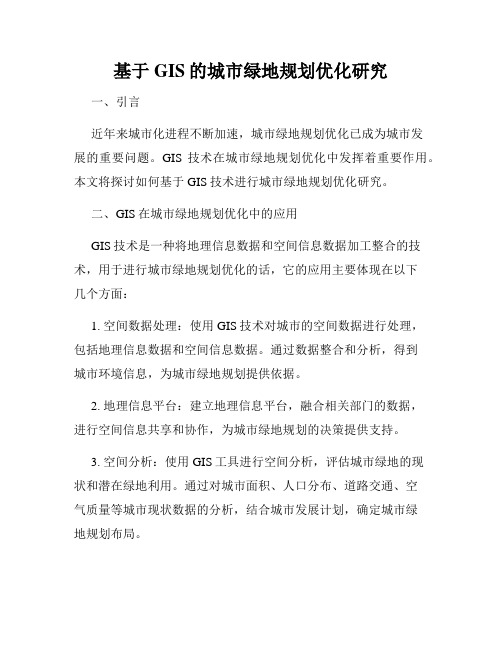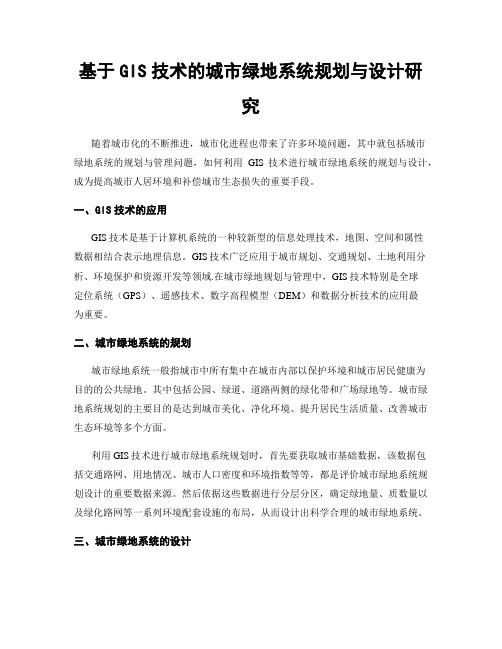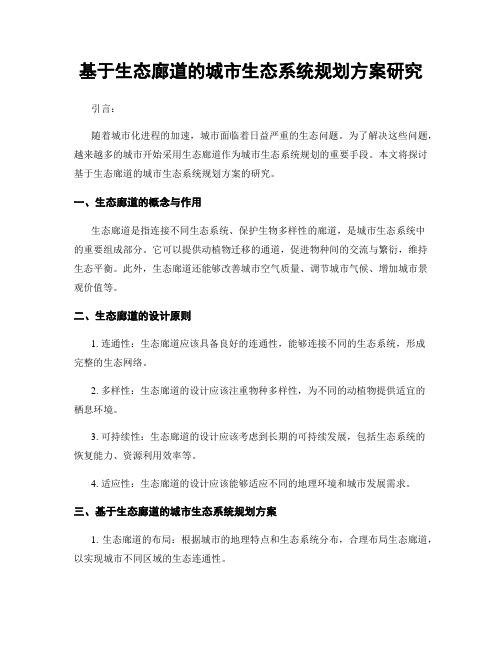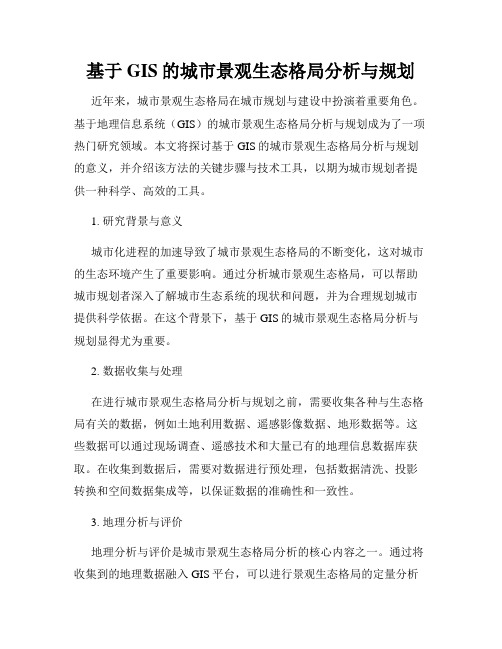基于GIS的城市生态廊道形态研究
基于GIS技术的城市绿地规划与设计研究

基于GIS技术的城市绿地规划与设计研究随着现代城市化的快速发展,城市绿地的规划与设计成为了城市建设的重要组成部分。
而在城市绿地规划与设计中,GIS技术的应用已经成为了不可或缺的一环。
本文将从GIS技术在城市绿地规划与设计中的应用出发,结合实际案例进行探讨,探究其优势和挑战。
一、GIS技术在城市绿地规划与设计中的应用GIS技术是一种基于地图的信息系统,可以对地理空间数据进行收集、存储、处理、分析和呈现。
在城市绿地规划与设计中,GIS技术可以实现如下功能:1. 信息收集和整合GIS技术可以帮助规划者收集和整合城市绿地相关的信息,包括绿地的位置、面积、形状、土地性质、土壤质量等各种信息。
这些信息可以帮助规划者了解城市绿地的现状和潜力,从而更好地进行规划与设计。
2. 空间分析和决策支持GIS技术可以进行空间分析和决策支持,帮助规划者进行城市绿地规划和设计。
通过空间分析,规划者可以精确地了解城市绿地的分布情况,评估不同绿地类型的作用和价值,选择合适的绿地类型和位置,并进行规划设计。
通过决策支持,规划者可以运用空间分析的结果,制定可行的规划方案,并进行实施和管理。
3. 地理可视化和交流沟通GIS技术可以进行地理可视化和交流沟通,使规划者能够直观地表达和展示城市绿地的规划与设计。
通过地理可视化,规划者可以将城市绿地的分布、类型、作用等信息以图形化的方式呈现出来,以便更好地向公众展示。
通过交流沟通,规划者可以与公众以及相关利益方进行沟通,收集意见和建议,修正规划方案,提高规划效果。
二、实际案例分析1. 上海市公园绿地系统规划上海市公园绿地系统规划,是上海市城市绿地规划与设计的重要组成部分。
该规划旨在建立全面、系统、科学的上海市公园绿地体系,提高城市整体绿化水平,并满足居民公园绿地需求。
在规划过程中,GIS技术发挥了重要作用。
通过GIS技术,规划者收集汇总了上海市公园绿地的各种信息,包括位置、面积、形状、土地性质、土壤质量等。
基于GIS的城市绿地规划优化研究

基于GIS的城市绿地规划优化研究一、引言近年来城市化进程不断加速,城市绿地规划优化已成为城市发展的重要问题。
GIS技术在城市绿地规划优化中发挥着重要作用。
本文将探讨如何基于GIS技术进行城市绿地规划优化研究。
二、GIS在城市绿地规划优化中的应用GIS技术是一种将地理信息数据和空间信息数据加工整合的技术,用于进行城市绿地规划优化的话,它的应用主要体现在以下几个方面:1. 空间数据处理:使用GIS技术对城市的空间数据进行处理,包括地理信息数据和空间信息数据。
通过数据整合和分析,得到城市环境信息,为城市绿地规划提供依据。
2. 地理信息平台:建立地理信息平台,融合相关部门的数据,进行空间信息共享和协作,为城市绿地规划的决策提供支持。
3. 空间分析:使用GIS工具进行空间分析,评估城市绿地的现状和潜在绿地利用。
通过对城市面积、人口分布、道路交通、空气质量等城市现状数据的分析,结合城市发展计划,确定城市绿地规划布局。
4. 地图制作:使用GIS技术进行地图制作,制作城市绿地规划方案地图,方便各方参考和沟通交流。
三、基于GIS的城市绿地规划优化方法基于GIS的城市绿地规划优化方法主要包括以下几个方面:1. 绿地规划优化模型的建立:绿地规划优化模型主要是指将城市的环境信息数据进行分析,建立绿地规划优化模型。
模型通过对城市现状和城市规划的评估,确定未来城市绿地的需求,并联合各方面的意见制定绿地规划方案。
2. 绿地规划方案的制定:基于绿地规划优化模型的建立结果和相关政策法规,制定符合城市发展方向和利益的绿地规划方案,确定绿地规划布局及绿地管理办法。
3. 绿地规划方案的实施和监测:绿地规划方案一旦确定,就要进行实施。
使用GIS技术对绿地规划方案的实施进行监测,及时纠正方案实施中出现的问题,保证绿地规划方案的执行质量。
四、案例分析以广州市芳村区为例,使用GIS技术对区域的绿地规划进行优化。
1. 空间数据处理:通过GIS技术对图像、生态、行政区划、地形地貌等信息数据进行整合和分析,得到广州市芳村区的绿化信息,为绿地规划提供依据。
基于GIS的城市生态廊道构建——以四川省万源市为例

韩 贵锋
HA N G u i f e n g用 景
Ab s t r a c t : T a k i n g Wa n y u a n c i t y f o r e x a mp l e , t h i s p a p e r e x p l o r e s t h e me t h o d o f
wo o d l a n d a r e e x t r a c t e d wi t h a Me a n F r a g me n t a t i o n I n d e x( MF I ) l e s s t h a n 0 . 4 a n d a n AI mo r e t h a n 8 0 %. T a k i n g t h e s e p a t c h e s a s s e e d p a t c h e s , s u i t a b l e a r e a o f e c o l o g i c a l
基于G I S 的城市生态廊道构 建*
以四川省万源市为例
Co n s t r u c t i n g Ur b a n Ec o l o g i c a l Co r r i d o r B a s e d o n GI S
—
A Ca s e S t u d y o f W a n y u a n Ci t y . S i c h u a n P r o v i n c e
碍 作用, 计算各类建设 用地对生态用地的
生态障碍 效应 , 并 得 到 景 观 的 潜 在 生 态 连接 度 。以平 均 破 碎 度 小 于0 . 4 和 聚 集 度
大于8 0 %的 阈 值 提 取 林 地 景 观 斑 块 , 依
t o e n e r g y l f o w , i n f o r ma t i o n l f o w a n d ma t t e r l f o w o f l a n d s c a p e ma t r i x . T h e p a t c h e s o f
基于GIS的城市绿地系统规划与设计研究

基于GIS的城市绿地系统规划与设计研究随着城市化的快速发展,城市绿地系统已成为城市可持续发展的重要组成部分。
作为城市生态系统中的一个关键要素,城市绿地系统对城市环境的改善、人们的身心健康、城市可持续发展等方面都具有重要作用。
因此,进行基于GIS的城市绿地系统规划和设计研究,促进城市可持续发展具有重要意义。
一、GIS在城市绿地系统规划中的应用GIS(地理信息系统)是利用电子计算机和相关软件进行空间数据采集、存储、管理、处理、分析、展示和应用的综合技术。
在城市绿地系统规划中,GIS技术主要应用于以下几个方面:1. 空间数据采集:通过GIS技术对城市中的绿地、道路、建筑等空间要素进行采集和整理,得到具有空间信息的数据,为城市绿地系统规划提供数据基础。
2. 空间数据处理:通过GIS空间分析功能,对城市绿地系统规划需要用到的空间数据进行加工处理,为城市绿地系统规划提供数据分析支持。
3. 空间数据分析:通过数据挖掘和空间分析方法,对城市绿地系统规划中的空间数据进行挖掘和分析,为城市绿地系统规划提供决策支持。
二、城市绿地系统规划的特点和要求城市绿地系统规划是一项需要综合考虑城市生态、社会经济、文化等多方面因素的综合性工程。
因此,城市绿地系统规划的特点和要求可以从以下几个方面来考虑:1. 整体性和系统性:城市绿地系统规划不只是考虑单个绿地的规划和设计,而是需要在城市整体规划的基础上,考虑绿地系统在城市环境中的作用和地位。
2. 可持续性:城市绿地系统规划应该考虑城市可持续发展的需要,综合考虑绿地系统的生态和社会效益,达到可持续发展的目的。
3. 人文化:城市绿地系统规划应该关注城市的人文环境,考虑城市绿地系统的景观美学和文化内涵,以提高绿地系统的空间品质。
4. 灵活性和可适应性:城市绿地系统规划应该考虑未来城市发展的需求,具备一定的灵活性和可适应性,在不断的变化和发展中,满足城市环境的需求。
三、城市绿地系统设计的方法和技术城市绿地系统设计是城市绿地系统规划的具体实施过程,通过设计达到城市绿地系统规划的目标和要求。
基于GIS技术的城市绿地规划设计研究

基于GIS技术的城市绿地规划设计研究城市化进程加快,城市绿地系统规划已经成为城市建设重要的组成部分。
科学合理的城市绿地规划设计,能够有效提高城市生态环境,改善人们生活质量。
GIS技术的广泛应用,为城市绿地规划设计提供了更加科学、精准、高效的技术手段。
一、GIS技术在城市绿地规划设计中的作用GIS技术能够采集、处理、分析大量的地理数据,并将其以图形和属性数据的形式展现出来,为城市绿地规划设计提供了精细的地理信息数据支持。
不仅如此,GIS技术还能够借助各种数据模型和算法,为城市绿地规划设计提供全面、科学、可靠的决策依据。
具体来说,GIS技术在城市绿地规划设计中的应用主要表现在以下几个方面。
1.城市绿地信息系统建设基于GIS技术,可以搭建完整的城市绿地信息系统,实现城市绿地信息的收集、管理、分析、展示等功能。
通过城市绿地信息系统,可以实现对城市绿地系统全面、精确、实时的掌控,为城市绿地规划设计提供了最基本、最重要的数据基础。
2.绿地分布分析基于GIS技术,可以对城市绿地的分布情况进行空间分析,找出城市绿地的空间布局特征和优劣势状况,为城市绿地规划的提高提供理论依据。
同时,还可以利用GIS技术进行模拟分析和预测,从而为城市绿地规划提供更加科学的支持。
3.绿地设计与评价在城市绿地规划设计中,GIS技术被广泛应用于绿地设计和评价。
通过建立各种绿地数据模型和算法,可以为绿地设计提供科学、可靠的依据。
同时,还可以基于GIS技术进行绿地效益评价,综合考虑不同层次的指标,为城市绿地规划提供决策支持。
在具体实践中,基于GIS技术的城市绿地规划设计方法包括以下几个阶段。
1.数据采集对于城市绿地规划设计而言,数据采集是十分重要的一环。
数据采集包括基础数据和评价数据两大部分。
基础数据主要包括地形地貌、土地用途、交通道路、水系、建筑分布等方面;评价数据则包括绿地覆盖率、绿地功能、人口密度、环境质量等方面。
2.数据整合基于采集的数据,利用GIS技术,将其整合成一张完整的城市绿地地图。
基于GIS技术的城市绿地系统规划与设计研究

基于GIS技术的城市绿地系统规划与设计研究随着城市化的不断推进,城市化进程也带来了许多环境问题,其中就包括城市绿地系统的规划与管理问题,如何利用GIS技术进行城市绿地系统的规划与设计,成为提高城市人居环境和补偿城市生态损失的重要手段。
一、GIS技术的应用GIS技术是基于计算机系统的一种较新型的信息处理技术,地图、空间和属性数据相结合表示地理信息。
GIS技术广泛应用于城市规划、交通规划、土地利用分析、环境保护和资源开发等领域.在城市绿地规划与管理中,GIS技术特别是全球定位系统(GPS)、遥感技术、数字高程模型(DEM)和数据分析技术的应用最为重要。
二、城市绿地系统的规划城市绿地系统一般指城市中所有集中在城市内部以保护环境和城市居民健康为目的的公共绿地。
其中包括公园、绿道、道路两侧的绿化带和广场绿地等。
城市绿地系统规划的主要目的是达到城市美化、净化环境、提升居民生活质量、改善城市生态环境等多个方面。
利用GIS技术进行城市绿地系统规划时,首先要获取城市基础数据,该数据包括交通路网、用地情况、城市人口密度和环境指数等等,都是评价城市绿地系统规划设计的重要数据来源。
然后依据这些数据进行分层分区,确定绿地量、质数量以及绿化路网等一系列环境配套设施的布局,从而设计出科学合理的城市绿地系统。
三、城市绿地系统的设计城市绿地系统的设计是基于城市绿地系统的规划,进一步指导将这些规划方案落实到实际场地上的过程。
在设计过程中,地形地貌、土地利用、城市规划和环境要素的特性都被考虑了进去。
在设计过程中,首先需要对城市绿地系统的用途和目的进行明确。
针对不同的用途和目的,绿地系统的设计也是不同的。
其次,要考虑城市环境、地形地貌的影响,以及市民文化和休闲活动的需求等。
借助GIS技术,可以依据平面地图等获取场地精确数据,并模拟出场地的实际情况,利用3D技术进行场地的立体仿真操作和体验评估,从而提出更为准确的方案设计。
四、城市绿地系统的管理城市绿地系统不仅要规划,更需要维护管理。
基于生态廊道的城市生态系统规划方案研究

基于生态廊道的城市生态系统规划方案研究引言:随着城市化进程的加速,城市面临着日益严重的生态问题。
为了解决这些问题,越来越多的城市开始采用生态廊道作为城市生态系统规划的重要手段。
本文将探讨基于生态廊道的城市生态系统规划方案的研究。
一、生态廊道的概念与作用生态廊道是指连接不同生态系统、保护生物多样性的廊道,是城市生态系统中的重要组成部分。
它可以提供动植物迁移的通道,促进物种间的交流与繁衍,维持生态平衡。
此外,生态廊道还能够改善城市空气质量、调节城市气候、增加城市景观价值等。
二、生态廊道的设计原则1. 连通性:生态廊道应该具备良好的连通性,能够连接不同的生态系统,形成完整的生态网络。
2. 多样性:生态廊道的设计应该注重物种多样性,为不同的动植物提供适宜的栖息环境。
3. 可持续性:生态廊道的设计应该考虑到长期的可持续发展,包括生态系统的恢复能力、资源利用效率等。
4. 适应性:生态廊道的设计应该能够适应不同的地理环境和城市发展需求。
三、基于生态廊道的城市生态系统规划方案1. 生态廊道的布局:根据城市的地理特点和生态系统分布,合理布局生态廊道,以实现城市不同区域的生态连通性。
2. 生态廊道的建设:在生态廊道的建设过程中,应该注重保护原有的生态系统,尽量减少对自然环境的破坏。
3. 生态廊道的管理:建立健全的生态廊道管理机制,加强对生态廊道的保护、监测和维护工作,确保其长期稳定运行。
4. 生态廊道的利用:合理利用生态廊道的功能,如开发生态旅游、生态农业等,为城市经济发展提供支撑。
四、国内外案例分析1. 新加坡:新加坡通过建设生态廊道,改善城市空气质量,提高城市的生态环境质量。
2. 美国芝加哥:芝加哥通过建设湖泊生态廊道,提升城市的景观价值,吸引更多的游客和投资。
3. 中国深圳:深圳通过建设深圳湾生态廊道,改善城市的生态环境,提高城市的生活质量。
五、生态廊道的挑战与前景1. 挑战:生态廊道的建设面临着土地利用、资金投入、政策支持等方面的挑战。
基于GIS的城市生态廊道构建——以四川省万源市为例

——以生态斑块为 “源” , 以BEI 为阻力表面计算得到的每 个像元上的 最小耗费距离成本。 ——研究区内的最大耗费 距离成本和最小耗费距离成本。 BEI和ECI均在ArcGIS9.3中建 模 计算。 1.3.3 生态廊道构建 根 据 景观 格局的分析, 依 据 景观 破碎度和斑块聚集度指数,选 取 现状 分布集聚 且破 碎度小的生态 斑块, 如 林 地 斑 块,作 为“ 种 子 斑 块” (S e e d
*国家自然科学基金资助项目 (41001364) ; 教育部博士点基金资助项目 (20090191120030)
作者简介 韩贵锋: 重庆大学建筑城规学院, 山地城镇建 设与新技术教育部重点实验室, 城乡 生态规划与技术科学团队, 博士, 副教 授, hangf@
2013年第3期 / 西部人居环境学刊 / 051
Pa t ch), 视为廊道 建 设 的起 始“垫 脚 石” ; 再参照和对比生态用地斑块的生 态连接度, 并综合考虑高程、 坡度和用 地现 状,尽量利用最大 或 较大的生态 连接度斑块来串联“种子斑块” , 从而 勾勒出生态廊道骨架和网络, 最终用于 规划实践中。
体之间的物种交换或景观 组之间直接 的物质、 能量交换和生物迁移 [8] 。城市 生态用地与建设用地呈现为阴阳共济、 平行生长的耦合关系, 通过城市生态用 地格局优化与构建 来反控城市建设用 地的形态和增长, 在追求城市与自然和 谐演进的进程中, 将极大地促进城市土 地资源高效集约利用、 城市空间结构优 化和城乡生态环境保护。 本文以四川省万源市城市规 划区 为例, 首先 使 用景观 指数 解释 城市规 划区生态用地的空间格局; 接着, 借助 GIS的空间分析功能, 分析不同土地利 用类型受到的障碍效应和空间阻力, 以 及林 地 景观潜在的生态连 接度, 将生 态连接概念延伸到城市规划中, 构建生 态廊道, 从而指导城市建设用地布局, 明确城市与自然和谐演进的图景。
基于GIS技术的城市绿地管理研究

基于GIS技术的城市绿地管理研究随着现代化城市的快速发展,城市面积的扩张与人口的增长,城市绿地的可持续性管理变得越来越重要。
针对城市空气质量、污染度等方面问题,城市绿地在进行环境修复和生态保护方面起着至关重要的作用。
因此,建立高质量城市绿地管理系统,对于城市可持续发展、人民健康生活和造福于社会的进步具有极为重要的意义。
面对如此庞杂的城市绿地资源管理难题,GIS技术在城市绿地资源管理中的应用显得愈发重要。
GIS技术能够通过从卫星图像和地理信息等方面收集数据,实现城市空间信息的快速获取和整合。
通过引入GIS技术,可以使城市绿地管理变得更加高效和负担。
以下是基于GIS技术的城市绿地管理研究的相关内容。
一、基于GIS技术的城市绿地空间管理城市绿地空间管理是城市绿地管理的一个重要方面。
通过GIS技术,可以对城市绿地空间进行动态扫描和数据管理。
通过卫星数据和同步数据的补充,城市绿地空间数据可以变得更加完整和精细。
GIS技术还可以为城市规划者和管理者更好地指导城市规划和城市绿地项目的开发。
二、基于GIS技术的城市绿地养护管理GIS技术可应用于城市绿地的养护管理,利用GIS技术平台,进行绿地信息收集、绿地审核、巡查统计、现场异常处理等操作。
通过对城市绿地的长势、施肥、病虫害等进行调查和分析,实现城市绿地的预警与调整。
进一步优化城市绿地的养护管理,保证城市绿地的可持续性发展。
三、基于GIS技术的城市绿地规划管理基于GIS技术的城市绿地规划管理可以解决城市绿化和城市管理之间的联系。
GIS技术可以很好地集成城市绿地规划、设计和开发,实现对绿地资源优化管理。
同时,基于GIS技术的城市绿地规划管理自动化程度高,不仅便于城市规划师和管理者的操作,还能更好地反馈和指导城市绿地规划的决策和策略。
综上所述,基于GIS技术的城市绿地管理研究,是促进城市绿化的可持续性发展、保障人民身体健康的一项重要技术手段。
基于GIS技术的城市绿地管理系统的应用为城市提供了一个高效的城市绿地管理解决方案。
城市规划中的生态廊道网络设计与研究

城市规划中的生态廊道网络设计与研究引言随着城市化的不断推进,城市面临着日益严重的环境问题,如空气污染、水资源短缺和生物多样性丧失等。
为了解决这些问题,生态廊道网络成为了城市规划中的重要策略之一。
本文将探讨城市规划中生态廊道网络的设计与研究,旨在为城市规划师和决策者提供有关如何构建可持续城市的指导。
一、生态廊道的概念与作用生态廊道是指通过连接自然和人工景观中的生态元素,形成一条具有生态功能的廊道,以促进生物多样性的保护和城市生态系统的恢复。
生态廊道网络的设计和建设可以提供以下几个方面的益处:1. 保护生物多样性:生态廊道网络可以连接不同的生态系统,为动植物提供迁徙和繁殖的通道,从而促进物种的迁移和基因的交流,有助于维持和增加城市生物多样性。
2. 改善城市生态系统:生态廊道网络可以增加城市绿地覆盖率,改善城市的气候环境,减少城市热岛效应和空气污染,提供生态系统服务,如水源保护和土壤保持。
3. 提供休闲和文化空间:生态廊道网络可以为居民提供休闲和娱乐的场所,增加城市的文化氛围,提升居民的生活质量。
二、生态廊道网络设计的原则在设计生态廊道网络时,需要考虑以下几个原则:1. 连通性:生态廊道网络应该能够连接不同的生态系统,包括自然和人工景观,以实现生物迁移和基因交流。
连接的方式可以是线性的,如河流和绿道,也可以是点状的,如湖泊和公园。
2. 多样性:生态廊道网络应该包含多样的生态元素,如湿地、森林、草地和花园等,以提供不同的生境和食物资源,吸引更多的物种栖息和繁衍。
3. 可持续性:生态廊道网络应该考虑到城市的可持续发展,例如利用雨水收集和再利用系统来满足植物的灌溉需求,减少对城市供水的依赖。
4. 参与性:生态廊道网络的设计应该充分考虑居民的需求和意见,通过社区参与的方式,促进居民对生态廊道的认同和保护。
三、生态廊道网络设计的实践案例1. 纽约高线公园:纽约高线公园是一条位于纽约曼哈顿的废弃高架铁路线改建而成的城市公园,通过建设绿道和植物景观,将城市中心的混凝土丛林转化为一个生态廊道,提供了休闲和文化空间,同时保护了城市的生物多样性。
基于地理信息系统的城市综合管廊规划与设计

基于地理信息系统的城市综合管廊规划与设计城市综合管廊是一种集输送、通信、供水、排水、电力等城市基础设施于一体的地下综合管线系统,是随着城市化进程而逐渐兴起的一种管线建设模式。
随着城市人口快速增长和城市面积扩大,城市基础设施建设将面临更大的挑战。
成为解决城市基础设施建设难题的有效途径之一。
一、城市综合管廊的发展历程与背景随着城市化进程的加速,传统的城市基础设施建设模式已逐渐暴露出诸多问题,如资源利用效率低、空间布局不合理、维护困难等。
为了解决这些问题,城市综合管廊作为一种新型的城市基础设施建设模式应运而生。
城市综合管廊,又称为“共同沟”,是指将管线集中在一个构筑物中,实现管线集约化、一体化的地下管廊系统。
它具有空间利用率高、维护方便、安全可靠等特点,是现代城市基础设施建设的重要组成部分。
二、城市综合管廊的概念与特点城市综合管廊是一种将管线、电缆、通信等多种设施集中在一个统一的地下空间中的基础设施。
其特点包括:1. 空间集约化:通过集中布局,减少了土地资源的浪费,提高了空间利用效率。
2. 维护方便:由于所有设施均集中在一个构筑物内,因此维护时只需进入管廊,无需对每个设施单独进行维护,降低了维护成本。
3. 安全可靠:管廊内部设有防火、防水、防盗等措施,确保了设施的安全运行。
三、国内外城市综合管廊发展案例分析国内外许多城市都在积极探索和实践城市综合管廊的建设。
例如,日本的东京、大阪等城市,通过建设综合管廊,有效解决了城市基础设施建设的诸多问题。
而在国内,北京、上海、广州等城市也在综合管廊建设方面取得了显著成果。
四、基于地理信息系统的城市综合管廊规划与设计方法地理信息系统(GIS)在城市综合管廊的规划与设计中发挥着重要作用。
通过GIS技术,可以实现对城市地下空间的精确测量和建模,为管廊的规划和设计提供有力支持。
具体方法包括:1. 数据采集与处理技术:利用GIS技术,可以对城市地下空间进行高精度测量和数据采集,为管廊的规划和设计提供基础数据。
基于GIS的城市景观生态格局分析与规划

基于GIS的城市景观生态格局分析与规划近年来,城市景观生态格局在城市规划与建设中扮演着重要角色。
基于地理信息系统(GIS)的城市景观生态格局分析与规划成为了一项热门研究领域。
本文将探讨基于GIS的城市景观生态格局分析与规划的意义,并介绍该方法的关键步骤与技术工具,以期为城市规划者提供一种科学、高效的工具。
1. 研究背景与意义城市化进程的加速导致了城市景观生态格局的不断变化,这对城市的生态环境产生了重要影响。
通过分析城市景观生态格局,可以帮助城市规划者深入了解城市生态系统的现状和问题,并为合理规划城市提供科学依据。
在这个背景下,基于GIS的城市景观生态格局分析与规划显得尤为重要。
2. 数据收集与处理在进行城市景观生态格局分析与规划之前,需要收集各种与生态格局有关的数据,例如土地利用数据、遥感影像数据、地形数据等。
这些数据可以通过现场调查、遥感技术和大量已有的地理信息数据库获取。
在收集到数据后,需要对数据进行预处理,包括数据清洗、投影转换和空间数据集成等,以保证数据的准确性和一致性。
3. 地理分析与评价地理分析与评价是城市景观生态格局分析的核心内容之一。
通过将收集到的地理数据融入GIS平台,可以进行景观生态格局的定量分析和定性评价。
例如,可以计算城市景观生态格局的多样性指数、分析景观的连通性和分布格局等。
这些分析可以帮助了解城市景观生态格局的现状和趋势,并为规划提供参考。
4. 景观规划与优化基于分析结果,可以进行城市景观规划与优化。
根据城市发展的需求和生态环境的要求,制定合理的景观规划方案,包括绿地布局、生态走廊的划定、自然保护区的设置等。
通过优化城市景观格局,可以提升城市生态系统的稳定性和可持续性,并改善城市居民的生活质量。
5. 技术工具与软件在进行基于GIS的城市景观生态格局分析与规划时,常用的技术工具和软件包括ArcGIS、ERDAS IMAGINE、ENVI等。
这些工具和软件提供了强大的地理数据处理和空间分析功能,使得城市景观生态格局分析与规划更加便捷高效。
基于GIS空间数据的城市生态修复规划研究

基于GIS空间数据的城市生态修复规划研究城市生态修复规划研究是近年来热门的话题。
在城市化的过程中,自然环境不断被改变和破坏,而城市生态修复规划正是为了恢复自然环境,实现城市可持续发展。
GIS空间数据技术的不断发展给城市生态修复规划带来了新的思路和方法。
一、GIS空间数据在城市生态修复规划中的应用GIS空间数据技术是指将地理空间区域与地图信息结合,通过模型分析、数据挖掘和可视化显示等方式,将空间数据展示出来。
在城市生态修复规划中,GIS空间数据技术可以帮助规划师了解城市的空间结构和地理环境,并从中选出最适合生态修复的区域。
GIS空间数据技术可以帮助规划师了解城市的空间结构和地理环境。
通过收集和整理城市的历史遗迹、文化遗产和各种自然生态系统的空间数据,规划师可以建立一个城市资源数据库,将数据进行数字化处理后,利用GIS技术进行空间分析,确定生态修复的重点区域。
GIS空间数据技术可以帮助规划师在城市规划中选择适宜的生态修复区域。
城市人口和聚落在不断增加,城市生态空间越来越受到挤压,生态环境面临着不小的挑战。
因此,在城市规划中,选定合适的生态修复区域非常重要。
GIS技术可以将城市各个区域的生态环境进行综合评价,筛选出最有利于生态修复的区域,从而制定出高效的生态修复规划方案。
二、GIS空间数据在城市生态修复规划中的案例分析南宁市是一个具有典型意义的城市化过程,面对的是城市化进程中不可避免的生态环境问题。
因此,南宁市开始探索基于GIS空间数据技术的城市生态修复规划。
南宁市采用了不同的空间分析方法,确定了适合生态修复的区域,并利用生态补偿和土地利用等政策鼓励市民和企业参与生态修复工作。
除了南宁市,多个城市都开始了基于GIS空间数据技术的城市生态修复规划工作。
例如,深圳、北京、上海等大城市都制定了一系列具有可持续性的生态修复规划,使城市在发展的同时能够实现生态环境的改善。
三、GIS空间数据技术在城市生态修复规划中的局限性尽管GIS空间数据技术在城市生态修复规划中具有重要的作用,但它也存在一些局限性。
基于GIS的生态环境评估研究

基于GIS的生态环境评估研究一、引言生态环境是人类生存和发展的基础,对其进行准确评估对于环境保护、资源管理和可持续发展具有重要意义。
地理信息系统(GIS)作为一种强大的空间数据分析和处理工具,为生态环境评估提供了有力的支持。
二、GIS 在生态环境评估中的应用(一)数据采集与管理GIS 可以整合来自不同来源的生态环境数据,如地形、土壤、植被、气候等。
通过数字化和空间化处理,将这些数据统一存储在地理数据库中,方便管理和查询。
(二)空间分析1、缓冲区分析可以确定污染源周围的影响范围,或者保护区域的边界缓冲区,为制定相关政策提供依据。
2、叠加分析将多个生态环境要素的图层进行叠加,分析它们之间的相互关系和综合影响。
3、网络分析用于研究生态廊道、水流路径等的连通性和可达性。
(三)可视化表达以直观的地图、图表等形式展示生态环境评估结果,使决策者和公众能够更清晰地理解复杂的生态环境状况。
三、基于 GIS 的生态环境评估指标体系(一)自然生态指标1、地形地貌包括海拔、坡度、坡向等,这些因素影响着水分、热量的再分配,以及土壤侵蚀和植被分布。
2、土壤质量如土壤类型、肥力、酸碱度等,对植被生长和土地利用有重要影响。
3、植被覆盖度反映生态系统的生产力和稳定性。
(二)水环境指标1、河流水质监测化学需氧量、氨氮、总磷等污染物的浓度。
2、水资源量包括地表水资源和地下水资源的储量和可利用量。
(三)大气环境指标1、空气质量如二氧化硫、氮氧化物、颗粒物等污染物的浓度。
2、气象要素如风场、温度、湿度等,对污染物的扩散和传输有重要作用。
(四)人类活动影响指标1、土地利用类型如建设用地、耕地、林地等的比例和变化情况。
2、人口密度反映人类活动对生态环境的压力。
四、基于 GIS 的生态环境评估案例分析(一)城市生态环境评估以某城市为例,利用 GIS 分析城市扩张对周边生态系统的影响。
通过对比不同时期的土地利用数据,发现城市建设占用了大量耕地和绿地,导致生态服务功能下降。
基于地理信息系统的城市综合管廊规划与设计

基于地理信息系统的城市综合管廊规划与设计基于地理信息系统的城市综合管廊规划与设计摘要:随着城市化进程的加速,城市基础设施的管网规划与设计日益重要。
城市综合管廊的建设是近年来出现的一种全新的城市基础设施建设模式,它通过在城市地下空间中进行规划,设计和建设一系列配置各类管道设施的管廊系统,实现对城市基础设施资源的整合利用和有效管理。
地理信息系统(GIS)技术作为一种能够在地理空间数据上进行分析和管理的信息技术工具,为城市综合管廊的规划与设计提供了有力的支持。
本文将以基于地理信息系统的城市综合管廊规划与设计为主题,探讨GIS在该领域中的应用。
关键词:地理信息系统(GIS),城市规划,综合管廊,设计一、引言城市化进程的加速,给城市基础设施建设提出了更高的要求。
传统的地下管线布设方式存在着各种困难,如管网交叉等问题,城市地下空间不断被复杂的管线网络占据。
综合管廊的建设模式因此应运而生,它通过在城市地下空间中规划、设计和建设一系列配置各类管道设施的管廊系统,将城市基础设施资源整合起来,实现对城市管线的有效管理和统一维护。
二、基于地理信息系统的城市综合管廊规划与设计的优势地理信息系统(GIS)作为一种能够在地理空间数据上进行分析和管理的技术工具,具有以下优势:1. 空间数据集成和管理能力:GIS可以对各种不同类型的数据进行整合和管理,包括地理位置信息、地下管道信息、土地利用信息等,为管廊规划与设计提供全面的数据支持。
2. 空间分析功能:GIS提供了一系列强大的空间分析工具,可以进行地理信息数据的查询、统计、可视化等操作,为城市综合管廊规划与设计提供科学依据。
3. 决策支持功能:GIS能够将数据和分析结果以图形化、可视化的形式展示,使决策者能够更直观地了解管廊规划与设计的相关信息,从而做出更科学的决策。
三、基于地理信息系统的城市综合管廊规划与设计的应用1. 基础数据采集与整合GIS通过采集和整合各类地理信息数据,如土地利用信息、地形地貌数据、地下管道数据等,为城市综合管廊规划与设计提供基础数据支持。
基于GIS和CFD的城市街道通风廊道研究——以武汉为例

中国园林 / 2019年 / 第35卷 / 第6期
文章编号:1000-6664(2019)06-0084-05 DOI:10.19775/j.cla.2019.06.0084 中图分类号:TU 986 文献标志码:A 收稿日期:2017-11-01 修回日期:2018-01-02 基金项目:湖北省教育厅科学研究计划中青年人才项目“宜昌 市热环境时空量化分析与规划策略研究”(编号Q20171201) 和湖北省建设科技计划项目“山地城市购物综合体交通流线组 织的量化与优化研究”共同资助
84
尹 杰 , 詹 庆 明 .基 于 GIS和 CFD 的 城 市 街 道 通 风 廊 道 研 究 —— 以武汉为例. 中国园林,2019,35(6):8 4- 8 8 .
基于GIS和CFD的城市街道通风廊道 研究——以武汉为例
Urban Street Wind Path Research Based on GIS and CFD—A Case Study of Wuhan
国内外相关学者和专家团队对城市微气候 的改善和城市通风展开了研究。德国卡塞尔市政 府于20世纪80年代组织开展了《“理想城市气
候”计划》[2],目的是改善城市空气质量,提高 宜居性。研究计划利用城市环境气候图的形式, 标出主要通风廊道及局地风的流通系统,将风 环境现状和评估后的规划建议用规划术语表达 出来,便于规划师和政府决策者参考和实施。 2003年中国香港中文大学建筑学院吴恩融教授 领导的国际团队开展《空气流通评估方法可行性 研究》[3-4]。针对香港的城市形态和结构,从街 道布局、建筑物高度,以至开敞空间的布置,建 筑密度的控制、绿化等方面检视现有城市规划和 设计的问题。
基于GIS的城市绿地生态系统评价研究

基于GIS的城市绿地生态系统评价研究随着城市化进程的加速,城市绿地和生态系统的重要性越来越受到关注。
城市绿地不仅是城市景观和生态系统的重要组成部分,而且其生态系统服务功能也被认为是促进城市可持续发展的关键因素之一。
因此,如何科学地评价城市绿地生态系统成为了城市规划和生态环保领域的重要研究课题。
GIS(地理信息系统)是一种能够处理、分析和展示地理空间数据的工具。
借助GIS技术,可以更加准确地评价城市绿地生态系统的状况。
本文旨在探讨基于GIS的城市绿地生态系统评价研究。
一、GIS技术在城市绿地生态系统评价中的应用GIS技术可以为城市绿地生态系统评价提供强有力的支持。
在城市绿地生态系统评价中,需要对绿地类型、覆盖率、大小、空间分布等因素进行综合评价和分析。
而GIS可以通过分析数据,生成图层、影像和地理信息,进而进行各种空间分析和模型计算。
例如,利用GIS技术,可以较为准确地绘制出城市的绿地空间分布图,进而对绿地类型、数量、覆盖率等进行分析。
同时,GIS也可以较为精细地分析绿地的生态系统服务功能,包括空气质量调节、水资源保护、土壤保持等作用。
此外,GIS技术还可以对绿地的使用状况、开发程度、景观特征等进行评价。
二、城市绿地生态系统评价的指标体系城市绿地生态系统评价指标体系是评价城市绿地生态系统时所采用的各项指标和参数的总和,是进行城市绿地生态系统评价的基础。
目前,国内外已经有一些城市绿地生态系统评价指标体系的建立和应用,其中不乏基于GIS技术的应用。
常用的城市绿地生态系统评价指标包括:绿地覆盖率、绿地类型分布、绿地总面积、绿地均等度、绿地形态指数、生态系统服务价值、水资源保护、土壤保持、大气调节等。
此外,城市绿地的景观特征、开发程度以及绿地的社会、文化和历史价值也应纳入评价体系。
三、城市绿地生态系统评价的优势和难点相比传统的城市绿地生态系统评价方法,基于GIS技术的城市绿地生态系统评价具有很多显著的优势。
基于GIS的城市生态廊道形态研究

IV
重庆大学硕士学位论文
图 目 录
.................................................................................... 6 图 2.1 廊道示意图 .......................................................................................... 9 图 2.2 廊道功能类型 ..................................................................................... 10 图 2.3 垫脚石示意图 ..................................................................................... 11 图 3.1 台北城市局部分辨率为 1 米的灰度影像 .................................................... 25 图 3.2 北京的局部分辨率为 2.2 米................................................................... 25 图 3.3 泰山地区 TM 影像 ................................................................................ 26 图 3.4 根据解读标志提取得到的泰山地区的城市生态地物信息 ............................... 26 图 3.5 R2V 矢量化边界示意图 ......................................................................... 27 图 3.6 去除重叠示意图 .................................................................................. 27 图 3.7 拓展收缩后的效果 ............................................................................... 28 图 3.8 拓展示意图 ........................................................................................ 29 图 3.9 渥太华卫星遥感影像局部 ...................................................................... 32 图 3.10 同一影像在使用不同矢量化方法后得到的结果 ......................................... 32 图 4.1 R 值变化曲线的第一种典型特征 ............................................................. 33 图 4.2 R 值变化的第二种典型特征 ................................................................... 33 图 4.3 R 值变化的第三种典型特征 ................................................................... 33 图 4.4 R 值曲线可能存在的起始特征 ................................................................ 34 图 4.5 生态廊道宽度示意图 ............................................................................ 39 图 4.6 提取中心线选项 .................................................................................. 40 图 4.7 拓扑处理中错误处理选项的作用 ............................................................. 41 图 4.8 生态廊道网络连接的几种形态特征 .......................................................... 41 图 4.9 深圳生态绿道规划图 ............................................................................ 47 图 5.1 北京中心区卫片 .................................................................................. 51 图 5.2 北京中心区卫片提取后的城市生态地物信息 .............................................. 51 图 5.3 纽约中心区卫片 .................................................................................. 52 图 5.4 纽约中心区卫片提取后的城市生态地物信息 .............................................. 52 图 5.5 南京卫片 ........................................................................................... 53 图 5.6 南京卫片提取后的城市生态地物信息 ....................................................... 53 图 5.7 罗马卫片 ........................................................................................... 54
城市密集建成区生态廊道体系规划研究

城市密集建成区生态廊道体系规划研究刘婕摘要:众多城市经历了高速的城市化发展,形成了城市的密集建成区,建设用地连绵、生态用地破碎严重、生态安全问题尤为突出。
此类地区由于用地紧张,难以腾挪出大面积土地规划生态斑块,因此建立互联的生态廊道,充分发挥绿地系统整体规模效应,对保护密集建成区生态安全格局显得尤为重要。
文章以广州市都会区为例,在GIS技术的支撑下,采用最小耗费距离模型、障碍影响指数方法评估生态连接度,拟定生态廊道最佳路径,并考虑控规可实施性划定生态廊道体系空间边界,优化了广州密集建成区的绿地布局。
生态廊道体系规划方法与论证过程,可为其它城市密集建成区绿地系统优化提供技术参考。
关键词:城市密集建成区;生态廊道;生态安全格局改革开放后,我国的经济高速成长,令城市建设取得了举世瞩目的发展成就。
然而与此同时,城市空间资源利用与生态环境保护的矛盾日益凸显。
尤其是城市密集建成区作为城市人口与建设集聚的核心区域,城市建设用地连绵发展、生态用地面积逐年减少,孤岛化、破碎化的生态绿地,导致城市生态调控能力和恢复能力急剧下降[1],城市生态安全问题尤为突出。
为了减少城市绿地的破碎化,生态学家和生物保护学家开始提倡通过规划和发展城市绿地生态廊道来维持和增加绿地的连接[2]。
连接的绿地斑块可以促进基因流动、协助物种迁移,对于生态安全格局维护起着至关重要的作用[3]。
因此,对于难以腾挪出大面积土地规划生态斑块的城市密集建成区,建立生态廊道链接生态斑块,能起到充分发挥绿地系统整体规模效应的作用。
本文以广州市密集建成区——都会区为例,探索了特大城市密集区更为有效的生态保护与建设途径,从而切实改善城市宜居环境品质,以期为其他城市绿地系统规划与建设提供参考。
1 城市密集区生态廊道体系规划方法研究本文生态廊道体系是指包括带状生态空间及其联系的面状生态区,是以连接和贯通为特征的,由水系、农田、山林地、各类城市绿地及部分低密度、低强度建设地区构成的空间网络体系。
- 1、下载文档前请自行甄别文档内容的完整性,平台不提供额外的编辑、内容补充、找答案等附加服务。
- 2、"仅部分预览"的文档,不可在线预览部分如存在完整性等问题,可反馈申请退款(可完整预览的文档不适用该条件!)。
- 3、如文档侵犯您的权益,请联系客服反馈,我们会尽快为您处理(人工客服工作时间:9:00-18:30)。
Hale Waihona Puke IV重庆大学硕士学位论文图 目 录
.................................................................................... 6 图 2.1 廊道示意图 .......................................................................................... 9 图 2.2 廊道功能类型 ..................................................................................... 10 图 2.3 垫脚石示意图 ..................................................................................... 11 图 3.1 台北城市局部分辨率为 1 米的灰度影像 .................................................... 25 图 3.2 北京的局部分辨率为 2.2 米................................................................... 25 图 3.3 泰山地区 TM 影像 ................................................................................ 26 图 3.4 根据解读标志提取得到的泰山地区的城市生态地物信息 ............................... 26 图 3.5 R2V 矢量化边界示意图 ......................................................................... 27 图 3.6 去除重叠示意图 .................................................................................. 27 图 3.7 拓展收缩后的效果 ............................................................................... 28 图 3.8 拓展示意图 ........................................................................................ 29 图 3.9 渥太华卫星遥感影像局部 ...................................................................... 32 图 3.10 同一影像在使用不同矢量化方法后得到的结果 ......................................... 32 图 4.1 R 值变化曲线的第一种典型特征 ............................................................. 33 图 4.2 R 值变化的第二种典型特征 ................................................................... 33 图 4.3 R 值变化的第三种典型特征 ................................................................... 33 图 4.4 R 值曲线可能存在的起始特征 ................................................................ 34 图 4.5 生态廊道宽度示意图 ............................................................................ 39 图 4.6 提取中心线选项 .................................................................................. 40 图 4.7 拓扑处理中错误处理选项的作用 ............................................................. 41 图 4.8 生态廊道网络连接的几种形态特征 .......................................................... 41 图 4.9 深圳生态绿道规划图 ............................................................................ 47 图 5.1 北京中心区卫片 .................................................................................. 51 图 5.2 北京中心区卫片提取后的城市生态地物信息 .............................................. 51 图 5.3 纽约中心区卫片 .................................................................................. 52 图 5.4 纽约中心区卫片提取后的城市生态地物信息 .............................................. 52 图 5.5 南京卫片 ........................................................................................... 53 图 5.6 南京卫片提取后的城市生态地物信息 ....................................................... 53 图 5.7 罗马卫片 ........................................................................................... 54
重庆大学硕士学位论文
中文摘要
摘
要
城市中的生态廊道(ecological corridor)能有效串连生态孤岛,形成连续的城市 生态空间并提升生态空间的稳定性。生态廊道形态是城市生态规划中需要考虑和 依据的内容。但过去国内学者对城市生态廊道形态的量化描述研究一直较少涉足。 数字规划将传统的城市规划理论与以信息技术为代表的现代科学技术相结 合,在实践中逐步形成关于城市规划的量化理论与技术方法。数字规划的概念已 被广泛接受,并正在成为一个研究热点。加之目前规划领域极少将 GIS 作为规划 设计的分析手段加以运用,因此,本研究主要是探讨城市生态廊道的形态,提出 城市生态廊道形态量化描述指标,并形成基于 GIS 的对城市生态廊道形态的定量 描述与计算方法。 在前人对城市景观生态研究以及城市规划数字化方法研究的基础上,本研究 的核心是建立对城市生态廊道形态量化分析的指标。论文由绪论、生态廊道相关 研究理论综述、生态地物信息预处理方法、城市生态廊道形态特征与量化描述, 国内外城市生态廊道形态比较这五部分组成。通过对搜集得到的卫星图片进行城 市地物信息预处理,分离出生态地物图形信息的前提下,根据生态廊道形态的基 本特征,应用现有 GIS 应用软件进行特征值的计算。通过归纳这些形态的基本特 征值,将生态廊道归纳划分为线状、块状和带状三种形态。其中块状和带状的生 态廊道属于面状生态廊道的范畴。研究中提出生态廊道密度、节点密度、丰裕度 等七项城市生态廊道形态量化描述指标,这 7 个形态指标从 3 个方面反映了城市 生态廊道形态的主要特征。应用这些指标对中外城市生态廊道形态进行量化计算。 在中外城市生态廊道形态量化指标计算结果对比的基础上,总结得到国内外城市 生态廊道明显差异的 6 个方面。通过国内外各城市独特的地理、人文等因素,作 者探讨了国内外城市中生态廊道形态差异产生的原因与结果。中外城市生态廊道 形态量化结果的对比不仅反映了各城市生态廊道形态之间的差异,生态廊道形态 量化指标的合理性, 还反映了国内城市生态廊道形态可优化的途径。 因而基于 GIS 的城市生态廊道形态研究所提出的形态量化分析指标,可为国内城市进行生态廊 道合理规划提供形态数值的参考。 关键词:城市规划,生态廊道,GIS,形态
Ⅲ
重庆大学硕士学位论文
those in abroad. Based on the comparison of the calculation result, the research summarizes six evident differences of urban ecological corridors in domestic cities and those in abroad. The author discusses the reasons and results of all these differences through studying unique geographic and cultural factors in different cities. The comparison of the quantitative results not only reflects the morphological differences of urban eco-corridor among different cities and the rationality of the quantitative indexes, but also reflects the possible methods to optimize morphology of urban eco-corridors in domestic cities. Thus, the quantitative indexes of morphology in the morphological research of urban eco-corridor can provide numerical reference on morphology in the planning of urban ecological corridors in domestic cities. Key words: Urban Planning, Ecological Corridor, GIS, Morphology
